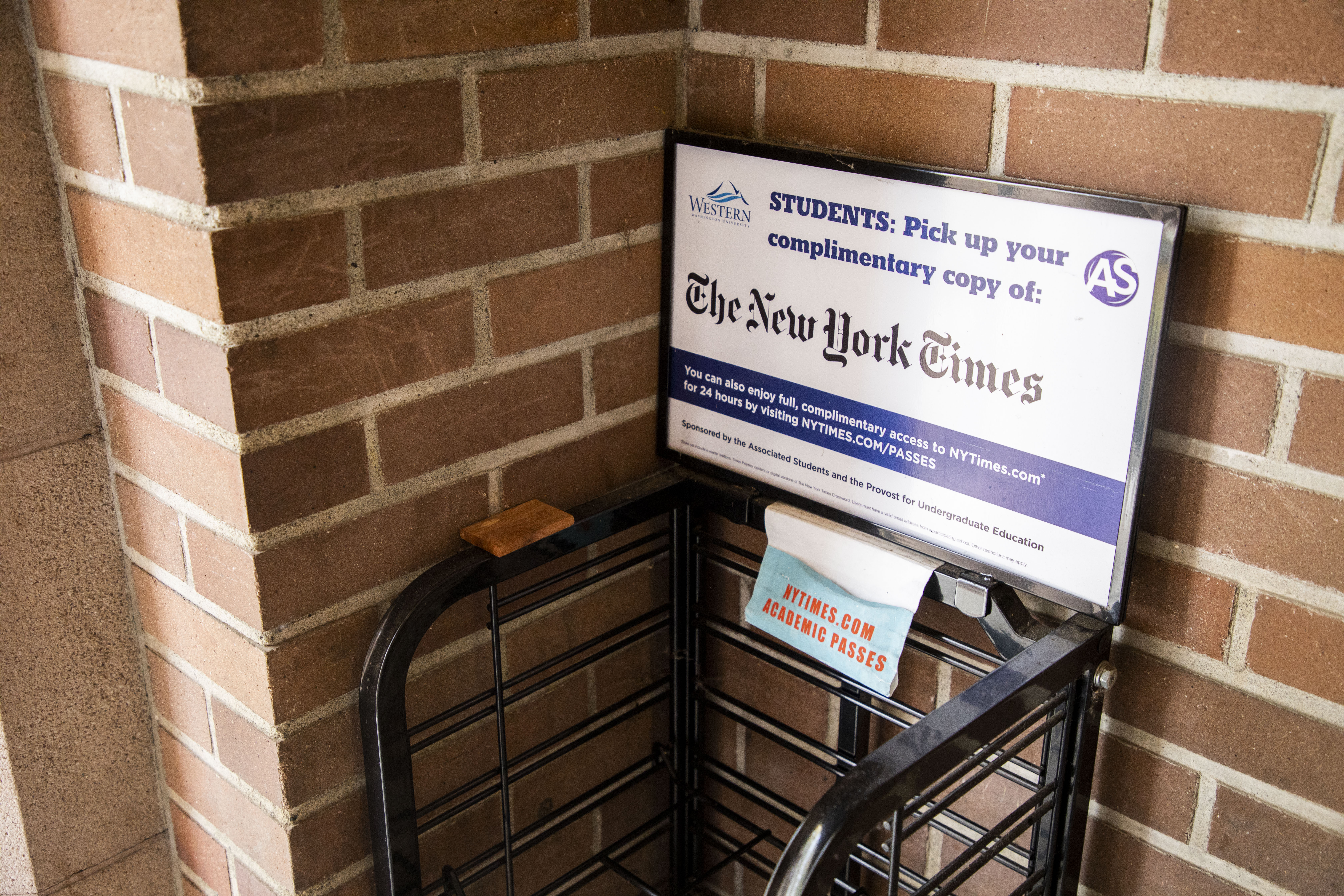An empty rack outside Wilson Library that used to hold The New York Times. Ella Banken//AS Review
The Wall Street Journal is being considered as a replacement.
By Soleil de Zwart
As of the the start of fall quarter, The New York Times is no longer available on campus.
Last year’s Associated Students Budget Committee suggested a change from The New York Times to The Wall Street Journal for reasons of sustainability and equity, not for the sake of budget cuts or for The Wall Street Journal’s editorial stances, Brandon Lane, student at-large on the 2017-18 budget committee, said.
The AS was paying for $8,765 of the approximately $21,000 worth of physical copies of the Times on campus. The remaining portion was paid for by the Vice Provost for Undergraduate Education’s office, according to the AS budget recommendations for 2018-19.
“Historically, budget committee has always said [The New York Times] really isn’t worth it and the Board should seriously consider defunding this program,” Lane said.
Questen Inghram, a journalism student and writer for Klipsun, immediately noticed the absence of The New York Times.
“I would rather see them ban newspapers from campus than have The Wall Street Journal disgrace our campus,” Inghram said.
Journalism students came forward to Alyssa Bruce, opinion editor of The Western Front, to express their disappointment about the cancellation of The New York Times Bruce said.
“Lots of people were saying that they want the rest of campus to know that they find it important,” Bruce said.
Bruce wrote an op-ed article titled “The Times they are a-changin’” in the Front to voice the effect the decision had on the students, Bruce said.
In the op-ed, Bruce said the switch could have been for the sake of budget cuts or because The Wall Street Journal has wider audience appeal.
Lane responded to the opinion piece with a letter to the editor in the Front to convey the process of the budget committee’s decision.
“It was not, as your piece suggested, because of [The Wall Street Journal’s] editorial leaning or it being more cost-effective, it was actually more expensive than the NYT,” Lane said in the letter to the editor.
Alex LaVallee, last year’s AS VP for business and operations, said the cut originated from the Student Services and Activities fee being coupled with tuition. This coupling meant the fee increased alongside tuition, at the same percentage. For 2018-19, tuition increased 2.2 percent, meaning the fee could only increase by 2.2 percent as well., which was not as high as the budget committee had anticipated.
When the budgeting process began in winter 2018, the budget committee asked advisers within the AS to look for reductions in their budgets to ease the load of the committee, according to LaVallee.
Steve Vanderstaay, vice provost for undergraduate education, approved of the switch to The Wall Street Journal. Vanderstaay said the office would fund $14,000 of the $24,490, according to the meeting minutes.
On May 25, LaVallee presented a proposal by a Wall Street Journal representative for a contract between the Associated Students and The Wall Street Journal to the AS Board.
The Wall Street Journal would provide every student, staff and faculty member with an online access code at a quoted rate of $24,490 for a year, according to the proposal.
Although the overall cost is higher with this proposal, the cost per student goes down from $17.00 per month for the New York Times to $1.50 per month for The Wall Street, LaVallee said in the meeting minutes.
The Representation and Engagement Programs, which is in charge of The New York Times subscription, wasn’t a part of the decision to cancel the subscription, according to Eric Alexander, associate dean of student engagement and director of Viking Union facilities.
“The [REP] office was actually unaware that the decision was coming to the table last year, when the decision was made. And so we did not have a say in that. It was quite the rushed decision,” Nora Harren, REP director, said.
Last year’s Board approved the funding for one year of The Wall Street Journal, so that this year’s Board can make the final decision on it, Alexander said.
“From an economic standpoint [LaVallee] thought ‘Well, The Wall Street Journal offers more people the capacity to access it.’ However, I don’t think all the research was done to answer that question fully,” Alexander said.
Harren has created a survey to get feedback from students and faculty about their engagement with The New York Times. It is now available on the Western Involvement Network.
“So far I haven’t gotten any feedback that says ’Yay we’re glad that the newspaper is gone.’ It’s mostly kinda been kinda like distraught, and unhappy that there wasn’t any consideration of how the students felt about the newspaper on campus,” Harren said.
Harren’s research will help the AS Board in making the decision about how to proceed with any on campus national newspaper programs, Alexander said.
The subscription to The Wall Street Journal has not yet been initiated. At this moment the decision has not been finalized. The current AS Board is still weighing the options, Alexander said.
This week, Natasha Hessami, Nora Harren and Eric Alexander met to discuss the next steps for an on campus national newspaper subscription. Their suggestions will be brought up to the AS Board during winter quarter, according to Sam Frost, AS communications director.

